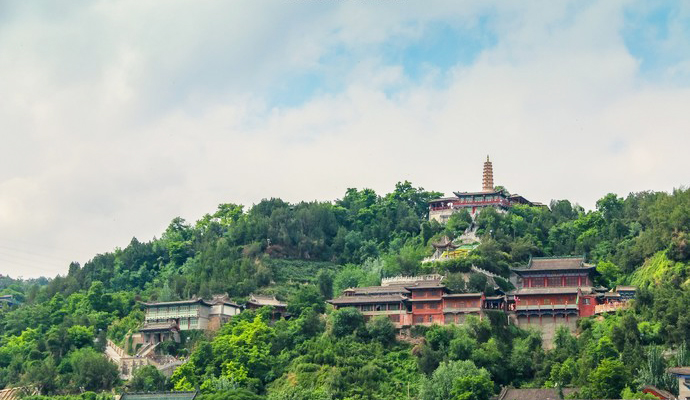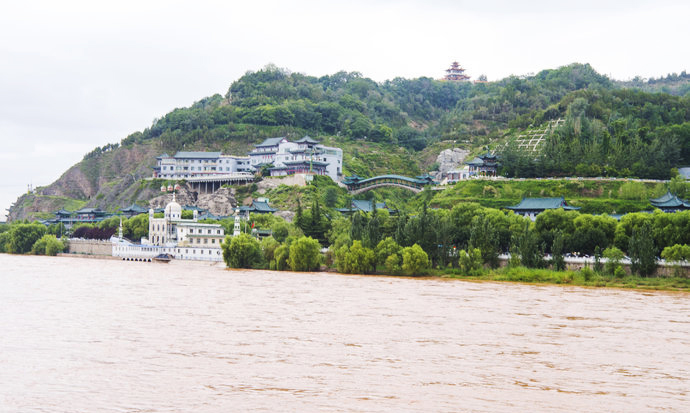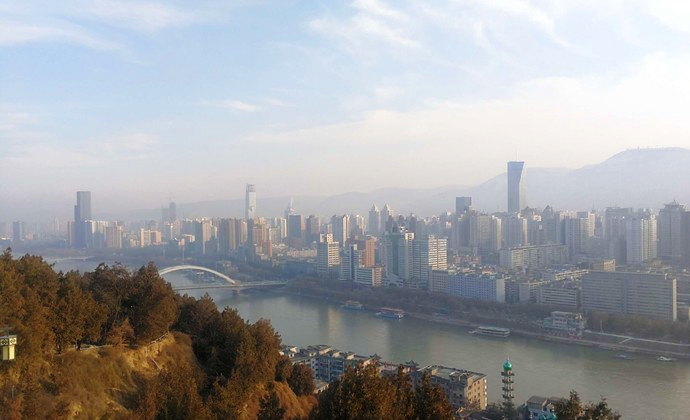White Pagoda Mountain Park

Resting on the northern bank of the Yellow River in the city of Lanzhou, the White Pagoda Mountain Park is unsurprisingly named for the startling White Pagoda Temple that sits on its summit. While the park was opened to the public in 1958, the architectural masterpieces that can be found throughout its vast expanse date back to ancient times, the most notable of which is the titular White Pagoda Temple. The history of the original pagoda is shrouded in mystery, although there is a local legend about how it came to be constructed.
According to this legend, Genghis Khan wrote a letter to the King of Tibet, within which he expressed his desire that Tibet be peacefully reunited. As an act of gratitude, the King of Tibet sent a highly-respected Lama from the Sakya sect of Tibetan Buddhism to pay a formal visit to Genghis Khan in Mongolia. This Lama, however, tragically died of illness in Lanzhou and never made it to his final destination. During this time, the Western Xia Dynasty (1038–1227) controlled much of Gansu province, including the city of Lanzhou. The city was eventually annexed by the Mongolian Empire in 1226 and, not long thereafter, the White Pagoda Temple was erected in honour of the Lama. Yet it seems as though the pagoda was doomed to suffer from the same bad luck that befell the Lama for whom it was built!
The original pagoda collapsed sometime towards the end of the Yuan Dynasty (1271-1368) and so the pagoda that we see atop the mountain today was actually rebuilt under the direction of a government official named Lou Yongcheng during the Ming Dynasty (1368-1644). It was also extended during the Qing Dynasty (1644-1912) at the behest of Chuo Qi, the governor of Lanzhou, in 1715.
The current pagoda towers in at 17-metres (56 ft.) in height and is composed of seven storeys, with its white exterior being complemented beautifully by an emerald-green spire at the top. It is octahedral in shape and each of its sides is decorated with elaborate Buddhist patterns. Small iron bells hang from the eaves of each storey of the pagoda, which produce a soothing sound whenever a breeze blows across the mountain.

Compared with other Buddhist pagodas, the White Pagoda has a highly unique shape. Most Buddhist pagodas are a combination of two main structural features: a multi-storied tower on the bottom; and a roof in the shape of an inverted bowl on top. The White Pagoda reverses this design, as its multi-storied tower is founded on top of huge inverted-bowl shaped segment, which is in turn supported by a large Sumeru pedestal that rests on a square base. In short, the pagoda’s structure is as complex as its history! From the top of the pagoda, visitors can enjoy a stunning panoramic view of Lanzhou and the surrounding countryside.
Alongside the pagoda itself, the temple complex was historically famed for its three treasures: the Elephant Leather Drum, the Bronze Bell, and the Chinese Redbud Tree. The Chinese redbud trees that once populated the mountain have unfortunately all withered and died due to their water sources drying up, but the Elephant Leather Drum and the Bronze Bell have stood the test of time. The Elephant Leather Drum is a huge drum that was reputedly donated to the temple by an unknown Indian monk, while the Bronze Bell was cast during the Qing Dynasty and weighs a colossal 153 kilograms!

The White Pagoda Mountain Park encompasses the entire temple complex and stretches from the summit of the mountain right down to Zhongshan Bridge at its base, which in turn crosses the Yellow River and was historically used by travellers along the Silk Road. The foot of the mountain is also marked by Jincheng Pass and Yudie Pass, which once served as military fortresses in ancient times. The park itself is dotted with a number of breathtakingly beautiful sights, such as decorative pavilions, roofed corridors, elaborate archways, and ancient trees. Some of the highlights of the park include: the Yellow River Stone Hall, which is a small exhibition dedicated to stones that have been taken from the Yellow River; the Yugur Reception Tent, where visitors can engage with the culture of the Yugur ethnic minority; and the Gongbei Mosque, which is one of the largest mosques in Lanzhou.
The term “gongbei” actually refers to the style of roof and derives from the Persian word gonbad or “dome.” It is a term used specifically by the Hui ethnic minority in China to denote a Muslim shrine that centred on the grave of a Sufi master. Since the term “gongbei” is popularly used in reference to Hui mosques, the Gongbei Mosque in Lanzhou is sometimes called Lingming or “Spiritual Life” Hall to differentiate it from others. It is important to note that, unlike other attractions in the park, the Gongbei Mosque is closed to the public and can only be enjoyed from the outside.